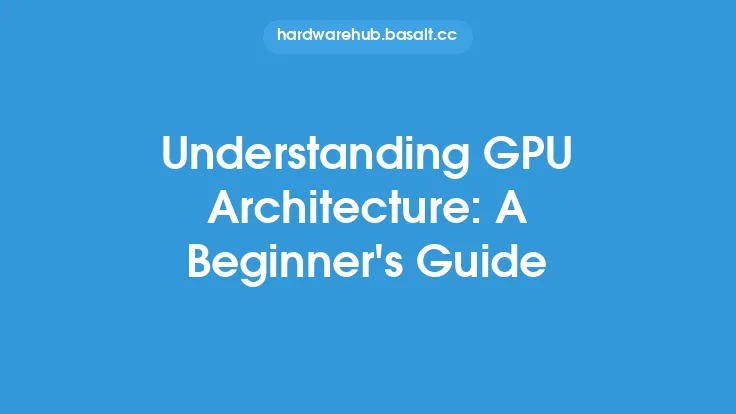The process of assigning a two-dimensional image to a three-dimensional object in computer graphics is known as texture mapping. This technique allows for the creation of detailed and realistic surfaces on 3D models, and is a crucial aspect of many applications, including video games, simulations, and visual effects. In the context of GPU architecture, texture mapping plays a significant role in determining the performance and efficiency of graphics rendering.
Introduction to Texture Mapping
Texture mapping involves mapping a 2D image, known as a texture, onto a 3D object. The texture is applied to the object's surface using a set of coordinates, known as texture coordinates, which define how the texture should be aligned and scaled on the object. The resulting image is then rendered on the screen, creating a detailed and realistic representation of the object. Texture mapping is used to add surface detail, such as patterns, colors, and normals, to 3D models, and is a key component of many graphics applications.
GPU Texture Mapping Units
In modern GPUs, texture mapping is performed by specialized units known as texture mapping units (TMUs). These units are responsible for fetching texture data from memory, applying texture coordinates, and performing the necessary calculations to map the texture onto the 3D object. TMUs are typically integrated into the GPU's execution units, such as the pixel shaders or vertex shaders, and work in conjunction with these units to produce the final rendered image. The number and performance of TMUs can significantly impact the GPU's texture mapping capabilities, with more advanced GPUs typically featuring multiple TMUs and higher performance.
Texture Addressing Modes
Texture addressing modes refer to the way in which the GPU accesses and addresses texture data in memory. There are several addressing modes, including wrap, clamp, mirror, and border, each of which determines how the texture is sampled and applied to the 3D object. The choice of addressing mode can significantly impact the appearance of the final rendered image, and is often used to create specific visual effects, such as seamless textures or detailed surface maps. In addition to the addressing mode, the GPU must also perform texture filtering, which involves interpolating texture values to produce a smooth and detailed image.
Anisotropic Filtering
Anisotropic filtering is a technique used to improve the quality of texture mapping by reducing the distortion of textures when viewed at shallow angles. This is achieved by using a set of filters that adapt to the orientation of the texture, allowing for more accurate and detailed rendering. Anisotropic filtering is particularly useful in applications where textures are viewed at a variety of angles, such as in video games or simulations. The performance of anisotropic filtering can be impacted by the GPU's texture mapping capabilities, with more advanced GPUs typically featuring higher quality and more efficient filtering.
Texture Compression
Texture compression is a technique used to reduce the amount of memory required to store texture data. This is achieved by using algorithms that compress the texture data, allowing for more efficient storage and transfer of textures. Texture compression can significantly impact the performance of the GPU, as it reduces the amount of memory bandwidth required to access texture data. There are several texture compression algorithms available, including S3TC, ETC, and ASTC, each of which offers a trade-off between compression ratio and image quality.
GPU Architecture and Texture Mapping
The architecture of the GPU can significantly impact the performance and efficiency of texture mapping. Modern GPUs typically feature a hierarchical memory architecture, with multiple levels of cache and memory that store texture data. The GPU's texture mapping units are responsible for accessing and processing this data, and the performance of these units can be impacted by the memory architecture. In addition to the memory architecture, the GPU's execution units, such as the pixel shaders and vertex shaders, also play a crucial role in texture mapping, as they are responsible for performing the necessary calculations to map the texture onto the 3D object.
Optimization Techniques
There are several optimization techniques that can be used to improve the performance of texture mapping on the GPU. These include using compressed textures, optimizing texture sizes and formats, and minimizing the number of texture switches. Additionally, techniques such as texture atlasing and texture batching can be used to reduce the number of texture bindings and improve performance. The choice of optimization technique will depend on the specific application and the requirements of the texture mapping process.
Conclusion
In conclusion, texture mapping is a critical component of many graphics applications, and is closely tied to the architecture and performance of the GPU. The GPU's texture mapping units, memory architecture, and execution units all play a crucial role in determining the performance and efficiency of texture mapping. By understanding the techniques and technologies used in texture mapping, developers can optimize their applications to achieve high-quality and efficient rendering, and take full advantage of the capabilities of modern GPUs.





